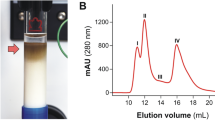Abstract
In an attempt to improve the specificity of the crudeTaenia saginata antigen for the immunodiagnosis of bovine cysticercosis, a major and highly immunogenic fraction (F10), responsible for the formation of the typical “long band” reaction in immunoelectrophoresis, has been isolated fromT. saginata proglottides by immunoaffinity chromatography. The immunoadsorbant was prepared by coupling a specifically raised hyperimmune serum (HIS) anti-F10 to Sepharose 4B.
The purity of the isolated F10 was demonstrated by immunoprecipitation reactions. The HIS anti-F10, however, cross-reacted with several larval and adultTaenia spp. Consequently, F10 showed cross-reactions with the sera of animals infected with hydatid cysts or larvalT. hydatigena. F10 also reacted with HIS anti-F5 (Echinococcus granulosus) but was shown to be non-identical with the well known F5 ofE. granulosus. These data prove that F10 ofT. saginata was not species-specific but showed a group specificity for the taeniid family — a situation analogous to F5 ofE. granulosus.
Similar content being viewed by others
References
Bout D, Fruit J, Capron A (1974) Purification d'un antigène spécifique de liquide hydatique. Ann Immunol (Paris) 125C:775–788
Geerts S, Kumar V, Aerts N (1979) Antigenic components ofT. saginata and their relevance to the diagnosis of bovine cysticercosis by immunoelectrophoresis. J Helminthol 53:293–299
Geerts S, Kumar V, Aerts N (1980) Rapid diagnosis of bovine cysticercosis by counterimmunoelectrophoresis. Ann Soc Belg Méd Trop 60:173–182
Pelley RP, Pelley RJ (1976) In: H van den Bossche (ed) Biochemistry of parasites and host-parasite relationships. N. Holland Publ, Amsterdam, p 283
Steinbuch M, Audran R (1969) The isolation of IgG from mammalian sera with the aid of caprylic acid. Arch Biochem Biophys 134:279–284
Vaitukaitis J, Robbins JB, Nieschlag E, Ross TG (1971) A method for producing specific antisera with small doses of immunogen. J Clin Endocrinol Metab 33:988–991
Varela-Diaz VM, Coltorti EA, Rickard MD, Torres JM (1977) Comparative antigenic characterisation ofE. granulosus andT. hydatigena cyst fluids by immunoelectrophoresis. Res Vet Sci 23:213–216
Varela-Diaz VM, Coltorti EA, D'Allessandro A (1978) Immunoelectrophoresis tests showingEchinococcus granulosus Arc 5 in human cases ofEchinococcus vogeli and cysticercosis-multiple myeloma. Am J Trop Med Hyg 27:554–557
Weeke B (1973) Crossed immunoelectrophoresis. In: NH Axelsen, J Kroll, B Weeke (eds), A manual of quantitative immunoelectrophoresis. Methods and applications. Universitetsforlaget, Oslo, p 47–56
Yarzabal LA, Bout D, Naquira F, Capron A (1977) Further observations on the specificity of antigen 5 ofEchinococcus granulosus. J Parasitol 63:495–499
Author information
Authors and Affiliations
Rights and permissions
About this article
Cite this article
Geerts, S., Vervoort, T., Kumar, V. et al. Isolation of fraction No. 10 fromTaenia saginata and evaluation of its specificity for the diagnosis of bovine cysticercosis. Z. Parasitenkd. 66, 201–206 (1981). https://doi.org/10.1007/BF00925727
Received:
Issue Date:
DOI: https://doi.org/10.1007/BF00925727




